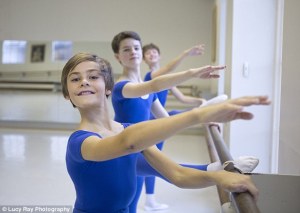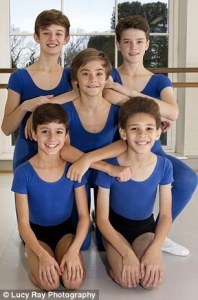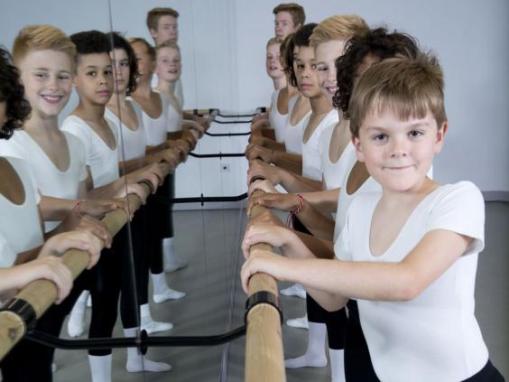From the day it opened, Paris Ballet and Dance has been the place where boys and young men go to learn to dance.
By Karina Felix
Florida’s World of Dance Magazine
February 18. 2016
PDF edition of article with pictures (pages 18-20)
[Jupiter, Florida, USA] – – From the day it opened, Paris Ballet and Dance has been the place where boys and young men go to learn to dance.
Like girls who take specialized pointe classes, boys also need classes geared specifically for their needs. As a renowned former world-class dancer and superb master teacher, Director Jean-Hugues Feray has always been aware of those needs. “Though very rewarding, being a man in the world of dance can be strenuous” says Feray. “They must not only be a good dancer but they also must be strong and well trained for the stylized steps, jumps and turns that they perform. They also need to be strong enough to lift a living human body weight and effortlessly transport it across the stage and gently place it down without breaking a sweat, or so it seems.”
BOY/MEN’S CLASS
Paris Ballet and Dance has special classes for young men and boys to teach them the proper approach and execution of steps, turns, jumps and “tricks” required of any professional male dancer. These classes also incorporate training for strength, conditioning, endurance and stamina.
PARTNERING CLASS
Partnering is a separate class. This class works on “pas de deux”’ (partnering) technique. In these classes a male dancer uses the strength, agility and balance he has acquired during his years of training to finesse the dance choreography with their partners. These young men learn how to properly lift, turn and guide their partners by working with the advanced students at the School. They also get the opportunity to implement and expand their knowledge and dance experience on stage during the schools yearly performances and Nutcracker showcase.
All classes are taught by experienced teachers whom are, or were dance professionals. These classes have given the serious dancers a huge advantage when they go off to summer intensives throughout the world. They are by far better equipped and prepared for the challenge.
As the male students grow older and stronger, the classes are adjusted to suite their immediate needs and requirements to becoming more proficient in their art form.
BOYS AS TRUE ATHLETES
Serious advanced dance students (and professionals) practically train on a daily basis throughout the year, with only a few breaks. Dance training require a strong disposition, made up of talent, desire, commitment, and a willingness to work hard. With dance training comes incredible control, strength, power, stamina, agility and flexibility. These are the attributes every sport demands. In fact, many professional and college teams require their members to attend ballet classes.
With that in mind, Paris Ballet and Dance’s talented boys and young men train very hard and are encouraged in an extremely positive way. Mr. Feray and his teachers always bring out a student’s passion for dance by pushing them to be stronger and better while preparing them for the dance world. All of the boys enjoy and look forward to their special hours in the classroom created just for them!
AN UNCOMMON SIGHT
Paris Ballet and Dance has so many boys and young men from ages four to seventeen mingling within the studio walls, that the other students and parents have become pretty used to seeing them interacting with the teachers and fellow dancers. “At Paris Ballet & Dance, we are excited and proud to not only have these group of young men at our studio, but that we are able to retain them because of the superb and individual based training we have created for them”: says studio director Jean- Hugues Feray.
WHY?
Paris Ballet and Dance is the School where boys and young men dance!
Mr. Feray was a student at the Paris Opera Ballet School and the National Conservatory of Paris. He danced with the French National Ballet of Nancy, The National Ballet of Marseille and performed alongside Paris Opera Ballet dancers throughout his career.
He started as an instructor during his years at Ballet Florida teaching at the Academy of Ballet Florida, under guidance of Mary Hale, and Alexander W. Dreyfoos School of the Arts in West Palm Beach, FL. He has performed for such notables as: Rudolph Nureyev, Pierre Lacotte, Vladimir Vasiliev, Marie-Claude Pietragalla, Maurice Bejart, Val Caniparoli, Ben Stevenson, Vicente Nebrada, Norbert Vesak, Steve Caras, Sean Lavery, Peter Martins and Jerome Robbins.
To say that he has the experience and expertise to guide these young men into a successful dance career is an understatement.
Mr. Feray has taken his dream and desire of guiding the new dance generation into new opportunities in the dance field by starting a dance conservatory for the very serious dancers: those willing to really dedicate their time and efforts to make it into the dance world.
This program has been created to cater to the homeschooled and virtual school student that can dedicate the amount of allotted time necessary for this type of training. There is also an after school option with Paris Ballet and Dance studio.
“Already in place on Saturday morning is an advanced boys class. We have enough 7 to 10 year old boys presently taking classes at the studio, that we are now able to start an intermediate class geared to young boys technique”, says Feray. You can reach Mr. Feray at Paris Ballet & Dance School and Conservatory at 861 Jupiter Park Drive – Unit F , Jupiter, FL 33458 http://www.parisballetdance.com/ 561-308-8377
Copyright 2016 World of Dance Magazine






















